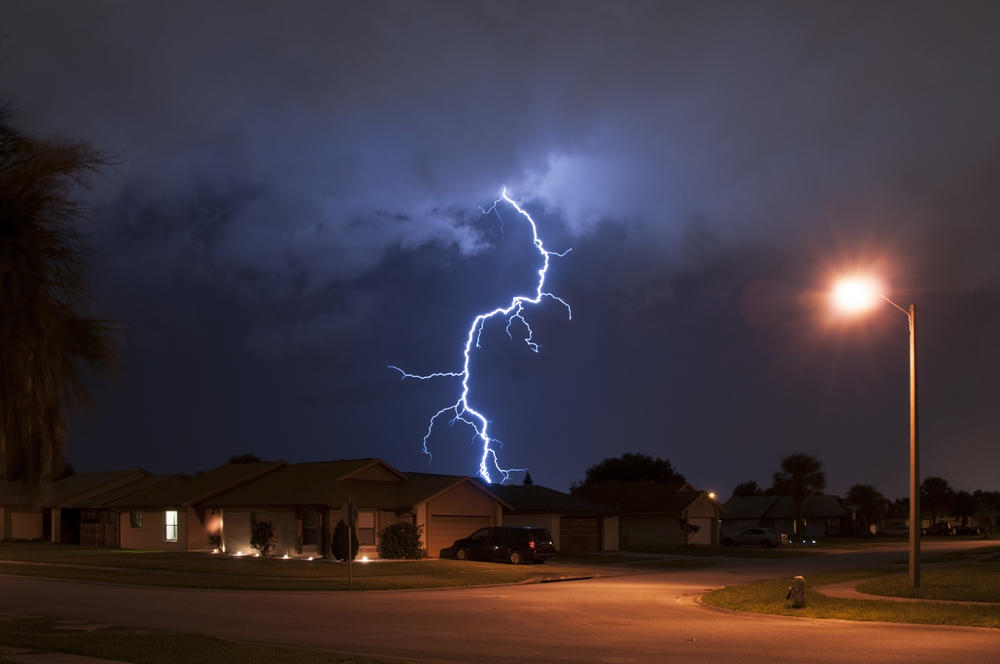Homeowners Insurance Lightning Claims Plunge, Yet Claim Costs Surge

The Insurance Information Institute (III) recently issued a press release that looks at both the number of lightning related claims as well as the cost of those claims. They found that for the second consecutive year, the number of lightning related claims decreased but the average cost per claim actually increased.
When the I.I.I ran the numbers, it showed that while lightning caused homeowner insurance claims decreased in 2019, the average cost per claim actually increased 11 percent between 2017 and 2019.
“It’s not surprising that lightning-related homeowners insurance claims costs have risen,” James Lynch, chief actuary and senior vice president of Research and Education at the I.I.I said in a recent press release. “Homes are more susceptible to lightning damage because electronic systems have become more interconnected – think Smart Homes – which have an easy gateway to much of a home’s electronic network, damaging scores of devices and appliances at once.”
Lynch also pointed out that the average cost per claim went up about 2.6 percent between 2018 and 2019 but went up a whopping 11 percent between 2017 and 2019 as the chart below shows.
Homeowners Insurance Claims And Payout For Lightning Losses, 2017-2019
|
The Top 10 States for Lightning Claims
Florida managed a first-place finish with 6,821 lightning related claims with Texas (5,780) in second place and California hitting third place with 5,100 claims. Texas moved up two spots from last year when it finished in fourth place and New York jumped up from eighth to sixth.
Texas had the highest average cost per claim at $15,278 with California ($14,105) running a close second and New York ($13,792) rounding out the top three.
Top 10 States For Homeowners Insurance Lightning Losses By Number Of Claims, 2019
| Rank | State | Number of claims | Value of claims ($ millions) | Average cost per claim |
| 1 | Florida | 6,821 | $93.2 | $13,669 |
| 2 | Texas | 5,780 | 88.3 | 15,278 |
| 3 | California | 5,100 | 71.9 | 14,105 |
| 4 | Georgia | 4,436 | 49.3 | 11,115 |
| 5 | Louisiana | 3,540 | 31.9 | 9,025 |
| 6 | New York | 2,866 | 39.5 | 13,792 |
| 7 | North Carolina | 2,849 | 31.8 | 11,165 |
| 8 | Pennsylvania | 2,838 | 27.3 | 9,612 |
| 9 | Alabama | 2,514 | 30.3 | 12,051 |
| 10 | Illinois | 2,438 | 24.6 | 10,078 |
| Total, top 10 | 39,182 | $488.2 | $12,460 | |
| Other states | 37,678 | 431.8 | 11,461 | |
| Total U.S. | 76,860 | $920.1 | $11,971 |
Homeowners Insurance Coverage
Damage caused by lightning is covered by a standard homeowners insurance policy. This includes fire damage and most policies also cover damage that is caused by a power surge due to a direct hit by lightning. Power surges can cause severe damage to electronics, including appliances, computers, phone systems, electrical fixtures and even the electrical foundation of a home.
“When it comes to lightning, safety and liability are two important factors,” said Tim Harger, executive director of Lightning Protection Institute (LPI) in the recent I.I.I. press release. “The safest place in any lightning event is within a structure protected by a properly designed, inspected and certified lightning protection system. Lightning protection systems protect the electronic infrastructure, core and knock-on functions of properties and can significantly reduce the more than $900 million of insured claims.”
Tips from the Lightning Protection Institute:
- Take shelter in a home, large building or substantial, fully enclosed building, all preferably protected with a lightning protection system. Hard topped-vehicles are generally safe shelters, as well.
- Avoid areas where you will be the highest object. If caught in an open field with no nearby shelter, and your hair begins to stand on end (an indication that lightning is about to strike) drop down and crouch with hands on knees, rocking up on the balls of your feet. (The idea is to make as little contact with the ground as possible.) Never lie down flat or place your hands on the ground.
- Certain locations are extremely hazardous during thunderstorms. Avoid lakes, beaches or open water; fishing from a boat or dock; and riding on golf carts, farm equipment, motorcycles or bicycles. Take shelter in tunnels, subways, even ditches or caves if necessary—never under a tree.
- If caught on high ground or in an open area, seek shelter in the lowest area you can find and stay away from trees. A small grove of bushes or shrubs is preferable to lone trees.
- To avoid side flashes (voltage from a nearby struck object) stay clear of fences or isolated trees. Keep away from telephone poles, power lines, pipelines or other electrically conductive objects.
- Stay off the telephone! In your home, do not stand near open windows, doorways or metal piping. Stay away from the TV, plumbing, sinks, tubs, radiators and stoves. Avoid contact with small electric appliances such as radios, toasters and hairdryers.
